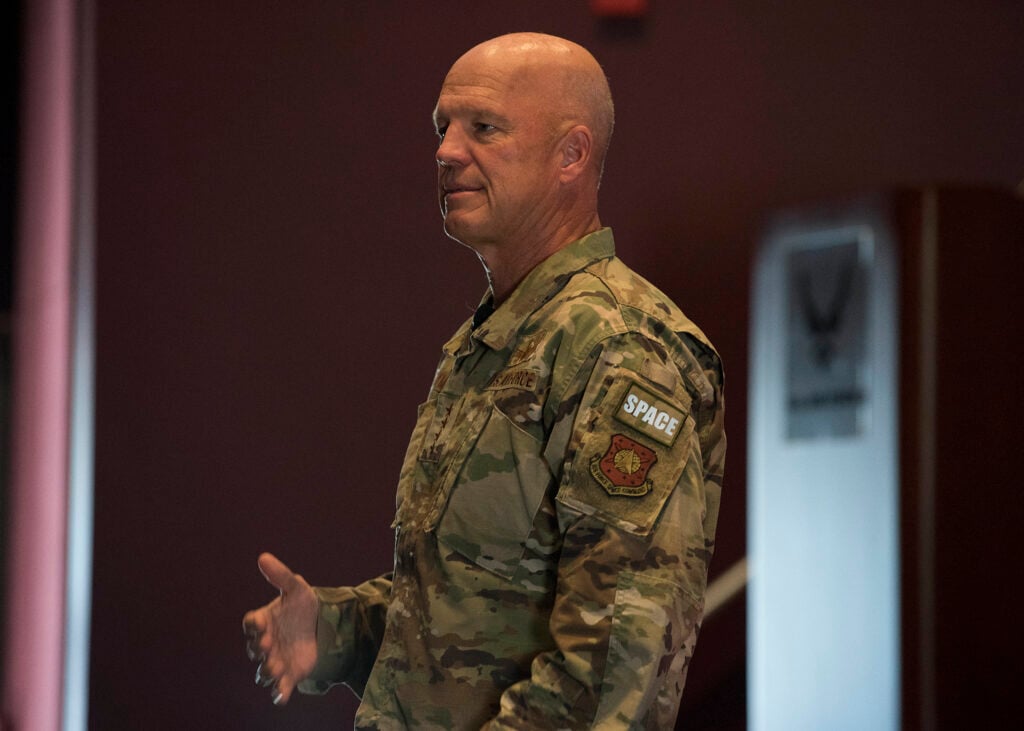By THERESA HITCHENS
 WASHINGTON: Space Command has again called ‘foul’ about Russia’s testing of its Cosmos 2543 satellite following its July 15 deployment of a secondary payload at high-speed. SPACECOM said the maneuver was a “non-destructive space-based anti-satellite test” that threatens US and allied space assets.
WASHINGTON: Space Command has again called ‘foul’ about Russia’s testing of its Cosmos 2543 satellite following its July 15 deployment of a secondary payload at high-speed. SPACECOM said the maneuver was a “non-destructive space-based anti-satellite test” that threatens US and allied space assets.
“The Russian satellite system used to conduct this on-orbit weapons test is the same satellite system that we raised concerns about earlier this year, when Russia maneuvered near a U.S. government satellite,” SPACECOM head Gen. Jay Raymond, said in a statement today. “This is further evidence of Russia’s continuing efforts to develop and test space-based systems, and consistent with the Kremlin’s published military doctrine to employ weapons that hold U.S. and allied space assets at risk.”
In response, Rep. Mike Turner, ranking member of the HASC strategic forces subcommittee, has called on Raymond to brief Congress “immediately” on the threat. “I strongly condemn Russia’s space-based anti-satellite weapons test, the latest in our adversaries’ aggressive behavior against the United States and our allies,” he said in a statement today.
And in a first, the UK Ministry of Defence also called out the Russians, with Air Vice-Marshall Harvey Smythe, head of the MoD Space Directorate, tweeting: “We are concerned by the manner in which Russia tested one of its satellites by launching a projectile with the characteristics of a weapon.” He further called on Moscow to refrain from such threatening testing in the future.
SPACECOM is tracking the object released by Cosmos 2543, numbered 45915 in the US military’s catalog of space objects, via its Space Surveillance Network of radar and optical telescopes. Independent observers also have been watching the Russian satellites.
“Object 45915 appears to have separated from Kosmos-2543 at about 0750 UTC Jul 15 at a fairly high relative velocity,” said Jonathan McDowell, an astrophysicist at the Harvard-Smithsonian Center for Astrophysics, in a Tweet on July 17.
Cosmos 2543 and its companion Cosmos 2542, launched in 2019 to Low Earth Orbit (LEO, up to 2,000 kilometers in altitude), are both maneuvering satellites that Russia has dubbed “inspectors”: Officially, they’re aimed at keeping an eye out for space debris and/or monitoring for shady activities by the satellites of others (read: spying on US satellites.) Raymond in February voiced concern about the two satellites “shadowing” a US KH-11 spy satellite, US 245 operated by the National Reconnaissance Office.
While a number of countries (including the US) and companies have undertaken on-orbit experiments that involve deploying a smaller craft from a satellite, the separation speed of Object 45915 from Cosmos 2543 is the concerning factor. It is not possible to be completely sure the move was designed to test a space-based weapon, experts say, but there aren’t a whole lot of other interpretations.
“I don’t see another obvious explanation other than it was a weapons test,” Brian Weeden, head of programming at Secure World Foundation (SWF) said in an email to me today.
McDowell tweeted that an ASAT test is one interpretation of the Russian move. “Or they did a servicing experiment and discarded a component,” he added.
SPACECOM, however, has no doubts that Cosmos 2543 is testing an ASAT.
“Last week’s test is another example that the threats to U.S. and Allied space systems are real, serious, and increasing,” SPACECOM said. “Russia’s development and testing of orbital weapons highlights the importance of establishing the U.S. Space Force as a new branch of the armed forces and the U.S. Space Command as the nation’s unified combatant command for space.”
“This event highlights Russia’s hypocritical advocacy of outer space arms control, with which Moscow aims to restrict the capabilities of the United States while clearly having no intention of halting its own counterspace program — both ground-based anti-satellite capabilities and what would appear to be actual in-orbit anti-satellite weaponry,” said Christopher Ford, the U.S. Assistant Secretary of State currently performing the duties of the Under Secretary for Arms Control and International Security, in SPACECOM’s press release.
Moscow, on the other hand, would be justified in pointing out that while the US been consistently critical for more than a decade of the efforts by Russia and China to draft space arms control treaties, Washington has never bothered to come up with its own recommendations. Indeed, back during the G.W. Bush administration, the US argued that there wasn’t any arms race in space that needed to be addressed by international accords — or even informal discussions at the United Nations.
And while the Obama administration actively pursued informal norm setting for space safety at the Committee on the Peaceful Uses of Outer Space (COPOUS) it, too, rejected negotiations on a legally binding space arms control treaty. COPUOS, in fact, does not have a mandate to discuss military matters; that is the purview of the Geneva-based Conference on Disarmament, where the US traditionally has blocked discussions of space arms control.
The US brouhaha over the Cosmos test “also brings up the need for having well-established norms of behavior, an agreed -pon understanding about what responsible actions are in space, and ways in which to bring up concerns if there are actions outside the norm,” Victoria Samson, SWF’s Washington office manager, said in an email to Breaking D.
Smythe, too, called on Russia “to work constructively with the UK and partners to encourage responsible behavior in space.”
No comments:
Post a Comment